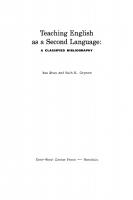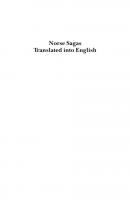Norse Sagas Translated Into English: A Bibliography 0404180167, 9780404180164
Foreword by Paul Schach. Norse or Icelandic is a difficult language taught only at some research universities. Masterin
239 75 6MB
English Pages 160 [162] Year 1980
Foreword by Paul Schach vii
Preface xi
Abbreviations xvi
Introduction xvii
Bibliography of Norse Saga Translations 3
Indexes
Translators 109
Editors of Icelandic Texts Translated 115
Names of Other Than Translators and Editors 121
Appendices
Some Discussions of Translation from Norse 127
A Selected List of Useful Books 129
Sagas for Translation 137
Recommend Papers
File loading please wait...
Citation preview
Norse Sagas Translated into English
AMS Studies in the Middle Ages, ISSN:
Mo. 3
0270-6261
Other titles in this series: 1. 2.
Josiah C. Russell. Twelfth Century Studies. 1978. Joachim Bumke. The Concept of Knighthood in the Middle Ages. 1981.
Norse Sagas Translated into English A Bibliography by Donald K. Fry
Foreword by Paul Schach
AMS, Press New York, N.Y.
Library of Congress Cataloging in Publication Data Fry, Donald K. Norse sagas translated into English (AMS studies in the Middle Ages? no. 3) Bibliography: p. Includes indexes. 1. Sagas— Translations into English— Bibliography. 2. English fiction— Translations from Old Norse— Bibliography. I. Title. II. Series. Z2556.F78 [PT7262.E5] 016.839'6'08 79-8632 ISBN 0-404-18016-7
Copyright
© 1980 by AMS Press, Inc. All rights reserved.
MANUFACTURED IN THE UNITED STATES OF AMERICA
For my parents
Foreword Norse sagas are prose narratives ranging in length from about twenty to four hundred pages.
The term
Norse (more precisely, Old West Norse) designates the language of Norway and Iceland before it diverged into Norwegian and Icelandic.
Closely related to the sagas are
shorter narratives known as þættir (singular þáttr 'strand of rope, section').
These tales owe their name to the fact
that most of them have been preserved as episodes or loose inserts in the konungasögur, which are chronicles or biographies of Scandinavian kings.
With few exceptions the
konungasögur deal with the kings of Norway beginning with Hålfdan the Black (d. c. 860) and ending with Håkon Hákonarsson (d. 1263).
Most of the earliest þættir relate
confrontations between Icelanders— usually skalds (poets)— and Norwegian kings. The three oldest konungasögur, which were compiled by monks at the Icelandic monastery at Þingeyrar during the last decades of the thirteenth century, are biographies of St. ólaf (d. 1030), ôlaf Tryggvason (d. 1000), and Sverrir Sigurdarson (d. 1202).
The first two, which have little
literary merit, were based on legends, oral anecdotes, and skaldic verses.
Although they were written to glorify St.
FOREWORD
viii
ôlaf and the ‘’missionary king” of the North, they also praise many Icelanders— especially poets— at the Norwegian court. Sverris saga, which was compiled from oral and written eye witness accounts, is the first masterpiece of Old Norse prose.
The composition is firm, and the style excellent
throughout.
It is important to note that in these three
works the king is portrayed as the secular and the religious leader of his people.
This view of kingship conflicted
sharply with the Church policy of ecclesiastical autonomy, which was vigorously opposed by the national church of Iceland. The greatest of the konungasögur is Heimskringla by Snorri Sturluson (d. 1241).
The nucleus of this monumental
work is Ôlafs saga helga, which is preceded and followed by a series of biographies of Norwegian kings from the time of Hålfdan the Black until the beginning of King Sverrir's struggle for power in 1177.
Heimskringla is not history in
the modern sense of the word, but an imaginative recreation of the past.
As a work of medieval prose literature, it is
surpassed only by the best of the íslendingasögur. Byskupasögur began to be written in the early decades of the thirteenth century.
Hunqrvaka ("Hifnger Awakener")
is a synoptic chronicle of the bishops of southern Iceland from 1055 until 1176.
This was followed by biographies
of Saint Þórlak and Saint Jon, the latter from the north of Iceland.
Also from this period is the biography of
Bishop Pål, the natural son of Þórlak's sister Ragnheid and Jon Loptsson, grandson of King Magnus Bareleg of Norway. At about this time, the earliest Íslendingasögur were
FOREWORD composed.
ix
These stories are so similar to the Ôlaf
biographies in spirit and form that they are regarded as transitional works between the konungasögur and the íslendingasogur.
They deal with poets and are constructed
largely on their skaldic verses. The Íslendingasogur are the most original prose genre in medieval literature.
They differ from contemporary
European literature and from oral tales in their emphasis on character delineation.
Indeed, character portrayal is,
to quote Peter Hallberg, *’the alpha and omega of this literary genre, which so often takes on the character of charged dialogues** (The Icelandic Saga, p. 73) .
The plots
of these stories are hard to remember, but the strong-willed men and women whose dramatic confrontations generate the action of these sagas are unforgetable.
Many of them are so
unique that they occur only in one story.
Because the authors
wrote with an air of detachment, some sagas have been the object of conflicting interpretations.
Volumes have been
written about Hrafnkels saga, a gem of narrative prose, and about Njáls saga, a profound tragedy that ranks with Parzival and Faust in world literature.
A key to the understanding
of some of the Íslendingasogur is provided by Sturlunga saga, a contemporary history of thirteenth-century Iceland. In 1226 the Tristan of Thomas of Brittany was translated at the request of King Håkon Hákonarsson.
Tristrams saga
was followed by a flood of Norwegian translations and adaptations of romances and other European literary genres. These translations inspired the creation of about 250 Icelandic imitations.
In intrinsic merit and influence on later
FOREWORD
X
Icelandic literature, Tristrams saga remains the most important of the riddarasögur. During the thirteenth and fourteenth centuries, dozens of fornaldarsögur were written.
Some are based on Eddie
and Eddic-like poetry and thus preserve old legends of Germanic heroes; others are wild, fantastic stories about vikings.
The most important is Völsunga saga, which is
closely related to the Middle High German Nibelungenlied. Völsunga saga inspired dramas and novels by Ibsen, William Morris, and Thomas Mann, as well as Wagner's Ring des Nibelungen. Much of this rich literature is available in English translations— if they can be found.
Even the experts can't
agree on how to distinguish between the two Vinland sagas or between one of them and an unrelated tale called, among other things, Grænlendinga þáttr. key to the vexing problem.
At long last we have a
The present bibliography provides
convenient access to all English translations of sagas and þættir as well as to the editions on which they are based. Even Arrow-Odd can now be located.
This bibliography will
be on my desk beside Guóni Jónsson's Nafnaskrå.
Paul Schach University of Nebraska-Lincoln
Preface Norse or Icelandic is a difficult language taught only at some research universities.
Mastering it requires several
semesters and usually an extended stay in Reykjavik.
Yet
many scholars and students must use Norse materials without any knowledge of the language, and general readers enjoy the sagas as literature even though they read them only in translation.
I compiled this volume primarily for them.
All reference books for this complex area assume a broad knowledge of both the language and the culture.
For
example, let us suppose a scholar in Russian history studying the Permian District learns that Arrow-OddPs Saga contains a description of a voyage there? having no Icelandic, he asks his reference librarian if a translation exists.
The
librarian sends him to the Bekker-Nielsen bibliography, which confuses and fails him.
The librarian then advises
him to search the Islandica bibliographies? not knowing whether to call this work an Íslendinga saga, a Konunga saga, a Fornaldar saga, or even an Edda, he searches all eight bibliographical volumes, with no success.
He
struggles with the two-volume Bibliography of Translations from Medieval Sources, only to fail.
He gives up.
No
extant reference book would turn up even one of the three
PREFACE
XU
printed translations for him. This bibliography seeks to aid the scholar or student with little or no Icelandic by listing all Norse sagas translated into English.
It assumes no knowledge of the
subject, culture, or language.
Our Russian history scholar
would find Arrow-Odd's Saga simply by looking it up in alphabetical order.
The Introduction traces some of the
various paths for finding data in this volume, and explains some of the quirks involved. Although I compiled this bibliography mostly for non specialists, Norse scholars should also find it useful, especially for alternative titles, classifications, editions rendered, etc.
For their use, I include a list of sagas
I believe someone ought to translate.
We need an adequate
rendering of Gull-PÓris saga or Samsons saga fagra more than another rendering of Auóunar þáttr vestfirzka, Njáls saga, or Grettis saga.
I also hope this slim volume
will inspire them to produce a parallel bibliography for poetry and reference books more intelligible to beginners and non-specialists.
Of course, even scholars who can
read Old Norse occasionally need a translation for rapid »
skimming or for checking difficult passages. No bibliographer finds everything, nor can he escape errors in so complex a book, so I request reports of any omissions or mistakes, however slight, as well as suggestion: for improving later editions.
I would also appreciate notio
(or copies) of new translations as they appear. Many people and institutions have assisted me in the compilation of this bibliography.
I wish to thank the
PREFACE
xiii
libraries of Stony Brook, Berkeley, Stanford, Binghamton, and Cornell for access to their collections, and especially Mr. Vilhjálmur Bjarnar of the Fiske Collection at Cornell. The Stony Brook interlibrary loan staff found obscure volumes with great accuracy and patience.
The Univ. of
Wisconsin Dept, of Scandinavian, St. Ansgar 's Scandinavian Catholic League, and J. M. Nosworthy supplied difficult items.
The New York Public Library and the Pierpont Morgan
Library gave access to some of their rarest volumes.
A
number of colleagues, friends, and translators assisted me, especially Joseph Harris, Patrick Heelan, Fred Heinemann, G. R. Hibbard, Gwyn Jones, Paul Schach, Walter Scheps, Jacqueline Simpson, Leif Sjöberg, Jón Skaptason, my son Jason, and my wife Joan.
I would also like to thank my
typist, Mary E. Bruno, and my editors at AMS Press for their patience.
Setauket, New York August 25, 1979
Donald K. Fry
Table of Contents
Foreword by Paul Schach Preface Abbreviations Introduction
Bibliography of Norse Saga Translations
vii xi xvi xvii
3
Indexes Translators
109
Editors of Icelandic Texts Translated
115
Names of Other Than Translators andEditors
121
Appendices Some Discussions of Translation fromNorse
127
A Selected List of Useful Books
129
Sagas for Translation
137
Abbreviations Tr.
Translated b y , occasionally translation.
Ed.
Edition translated, occasionally editor or edition.
Repr.
Reprinted.
Corr.
Corrected.
Rev.
Revision.
Univ.
University.
Introduction
This bibliography lists all Norse sagas I could find translated into English by the summer of 1979.
I define
saga rather loosely as a medieval Icelandic prose narrative. Properly speaking, Snorri Sturluson's Edda is not a saga, but I have included it (as well as some other odd pieces such as Norwegian laws) to assist non-specialists.
For each
saga, the bibliography lists the Icelandic title, the critical category, every published translation into English, and the edition or version actually translated.
A typical
entry follows: 150.
Viga-Glums saga, or Glúma, or Esphaelinga saga (Icelanders): B.
Tr. Lee M. Hollander, Viga-Glum's Saga and the Story of Ögmund Dytt (New York:
Twayne,
1972) 17-118. Ed. Jónas Kristjánsson, Eyfirðinga sögur (Reykjavik, 1956). The saga appears alphabetically under its traditional Icelandic title, with alternative titles noted.
“ (Icelanders)
indicates its critical category “Sagas of the Icelanders“ (íslendinga sögur), as explained below.
The entry cites
the translator and publication data on the translation.
INTRODUCTION
xviii
The abbreviation "Ed." indicates the edition or version actually translated, if I could determine it.
Otherwise
I note "Ed. not cited," and occasionally I make educated guesses at the sources.
Where more than one complete
translation exists, I mark the more reliable versions with an asterisk? notoriously bad translations and most of those not based directly on Icelandic texts are labeled "unreliable To avoid tiresome page turning and to facilitate interlibrary loan ordering, I make each entry as independent as possible, with full citations and few abbreviations. The bibliography also includes numerous cross-reference including alternative titles in Norse, popular English titles, saga authors where known (alphabetized by first name according to medieval practice), Icelandic literary terms, and some key words in English titles.
Many Icelandic
manuscripts have names, easily confused with saga titles? for example, Landnámabók is the title of a prose narrative found in three manuscripts, Hauksbók, Melabók, and Sturlubók. I list all four titles as separate items.
Some of the titles
and terms are no longer current, but I include them to facilitate using older books. Icelandic scholars traditionally divide sagas into three groups:
íslendinga sögur, Konunga sögur, and
Fornaldar sögur.
I quote below Halldor Hermannsson's
definitions in the prefaces to his bibliographies in Islandica I, III, and V respectively.
Íslendinga sögur,
or "Sagas of the Icelanders," are "sagas and tales . . . , historical and fictitious, the scene of which is Iceland, or which treat of Icelandic persons at home and abroad, from
INTRODUCTION
XIX
the settlement of Iceland in the ninth century until the end of the Commonwealth in 1264, and which were written before the end of the fourteenth century/* with a few later exceptions Konunga sögur are ’‘sagas of the kings of Norway . . . and all minor tales . . . connected with them, as well as the related, more or less historical sagas and tales concerning the Faroes, the Orkneys, Denmark, Sweden and Russia . . . . , from the earlier half of the ninth century down to the reign of King Magnús lagabætir (1263-80),” again with exceptions. The terms Fornaldar sögur or Mythical-Heroic sagas, express ”the notion of their writers of presenting sagas dealing with what to them was a distant age or 'fornöld,' that is, the times before the foundation of the kingdom of Norway and the colonization of Iceland,
....
written in the
latter half of the 13th and the earlier half of the 14th century.”
All of these categories prove somewhat elastic,
but especially the last one, which includes foreign tales, fictional burlesgues, and even rewritten epics.
Scholars
also refer to Lygisögur 'Lying-sagas0 and Riddarasögur, romances or court sagas, generally late in composition.
I
include the three categories in main entries to facilitate use of the confusing but invaluable Islandica bibliographies. I also label some entries ’’Romance,” and a few fit no category at all. Generally speaking, “saga” (plural sögur) labels longer stories, and ’’þáttr” (plural þættir) the shorter ones, although some titles confuse the two terms.
I alpha
betize Norse titles without regard to ’’saga” and “þáttr,” so, for example, we find the seguence:
Eiriks þáttr jarls
INTRODUCTION
XX
Hákonarsonar, Eiriks saga rauða, Eiriks þáttr rauða, and Eirlks saga viðförla. Non-specialists also find the Icelandic alphabet's extra characters somewhat confusing, but I retain them here since they appear in references and prove simple to learn: Æ, as = A e , ae .
Ö, 0/ Ö, 0,










